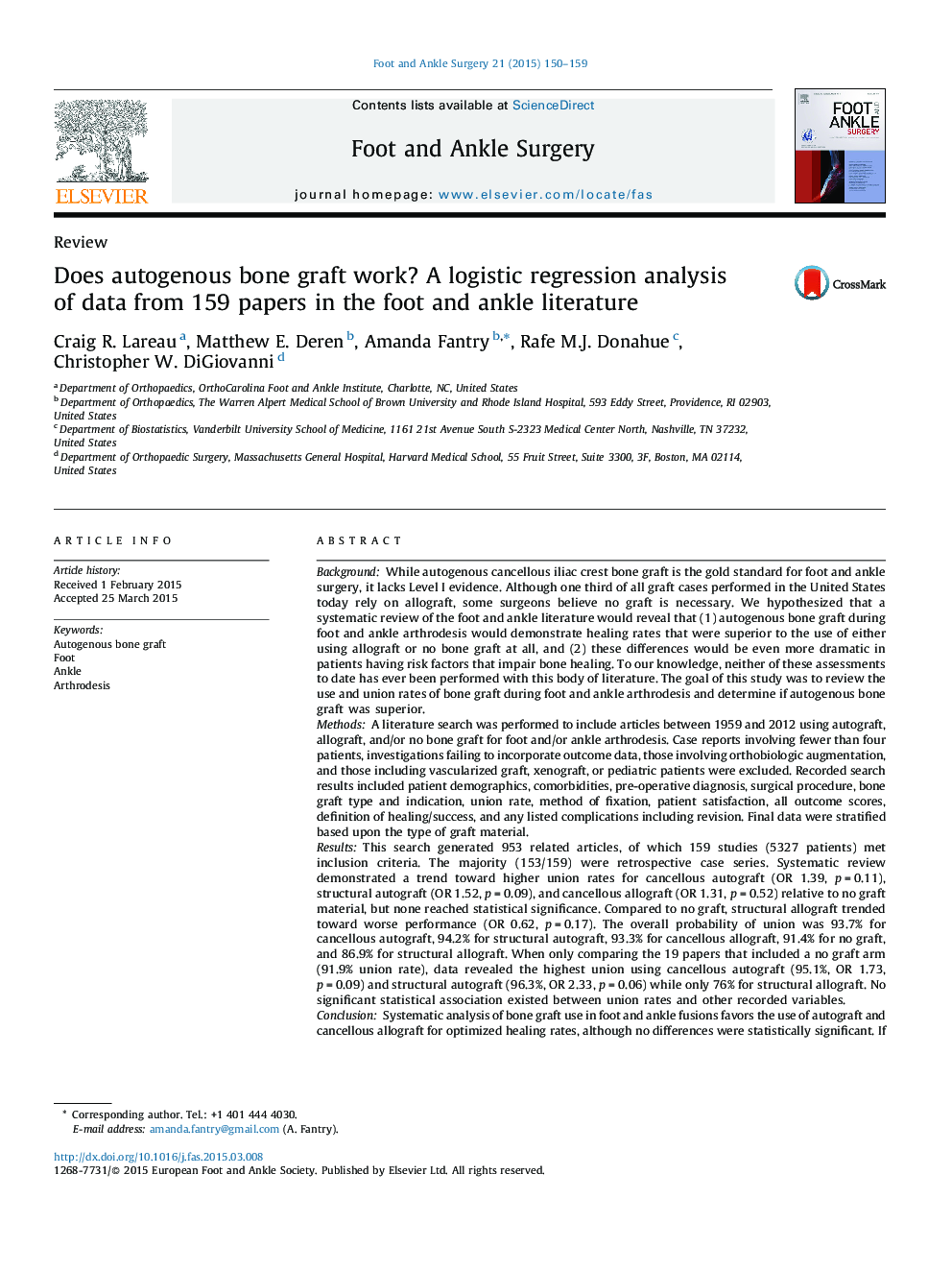| کد مقاله | کد نشریه | سال انتشار | مقاله انگلیسی | نسخه تمام متن |
|---|---|---|---|---|
| 4054518 | 1265524 | 2015 | 10 صفحه PDF | دانلود رایگان |
• We examine all available arthrodesis literature of the foot and ankle.
• Hypothesized that autogenous bone graft is superior to allograft or no graft.
• A significant lack of standardization and consistency exists across this data.
• No statistically significant association between bone graft type and other variables.
• Autograft and cancellous allograft favored, but not statistically significant.
BackgroundWhile autogenous cancellous iliac crest bone graft is the gold standard for foot and ankle surgery, it lacks Level I evidence. Although one third of all graft cases performed in the United States today rely on allograft, some surgeons believe no graft is necessary. We hypothesized that a systematic review of the foot and ankle literature would reveal that (1) autogenous bone graft during foot and ankle arthrodesis would demonstrate healing rates that were superior to the use of either using allograft or no bone graft at all, and (2) these differences would be even more dramatic in patients having risk factors that impair bone healing. To our knowledge, neither of these assessments to date has ever been performed with this body of literature. The goal of this study was to review the use and union rates of bone graft during foot and ankle arthrodesis and determine if autogenous bone graft was superior.MethodsA literature search was performed to include articles between 1959 and 2012 using autograft, allograft, and/or no bone graft for foot and/or ankle arthrodesis. Case reports involving fewer than four patients, investigations failing to incorporate outcome data, those involving orthobiologic augmentation, and those including vascularized graft, xenograft, or pediatric patients were excluded. Recorded search results included patient demographics, comorbidities, pre-operative diagnosis, surgical procedure, bone graft type and indication, union rate, method of fixation, patient satisfaction, all outcome scores, definition of healing/success, and any listed complications including revision. Final data were stratified based upon the type of graft material.ResultsThis search generated 953 related articles, of which 159 studies (5327 patients) met inclusion criteria. The majority (153/159) were retrospective case series. Systematic review demonstrated a trend toward higher union rates for cancellous autograft (OR 1.39, p = 0.11), structural autograft (OR 1.52, p = 0.09), and cancellous allograft (OR 1.31, p = 0.52) relative to no graft material, but none reached statistical significance. Compared to no graft, structural allograft trended toward worse performance (OR 0.62, p = 0.17). The overall probability of union was 93.7% for cancellous autograft, 94.2% for structural autograft, 93.3% for cancellous allograft, 91.4% for no graft, and 86.9% for structural allograft. When only comparing the 19 papers that included a no graft arm (91.9% union rate), data revealed the highest union using cancellous autograft (95.1%, OR 1.73, p = 0.09) and structural autograft (96.3%, OR 2.33, p = 0.06) while only 76% for structural allograft. No significant statistical association existed between union rates and other recorded variables.ConclusionSystematic analysis of bone graft use in foot and ankle fusions favors the use of autograft and cancellous allograft for optimized healing rates, although no differences were statistically significant. If we assume that graft material been chosen for more complex procedures having lower anticipated union rates, then these data lend further support to the use of autograft and cancellous allograft.Level of EvidenceLevel IV.
Journal: Foot and Ankle Surgery - Volume 21, Issue 3, September 2015, Pages 150–159
